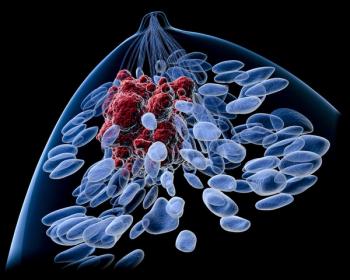
Prophylactic Cranial Irradiation With Hippocampal Avoidance Preserves Cognitive Function During SCLC Treatment
Hippocampal avoidance–prophylactic cranial irradiation was associated with better cognitive function preservation versus standard prophylactic cranial irradiation for small cell lung cancer.
During treatment for small-cell lung cancer (SCLC), sparing the hippocampus during prophylactic cranial irradiation (PCI) helped preserve cognitive function, according to a study published in the Journal of Clinical Oncology.
This phase 3 study (NCT02397733) found that the decline in delayed-free recall (DFR) on the free and cued selective reminding test (FCSRT) from baseline to 3 months was lower in the hippocampal avoidance–PCI (HA-PCI) arm compared with the PCI arm, at 5.8% vs 23.5%, respectively (odds ratio [OR], 5; 95% CI, 1.57-15.86; P = .003). Additionally, the median follow-up for living patients was 40.4 months.
“This phase III trial provides confirmation that conformal avoidance of the hippocampus during PCI better preserves NCF [neurocognitive function], while observing no difference between treatment arms in QOL [quality of life], intracranial relapse, and [overall survival] in patients with SCLC,” wrote investigators of the study.
This study enrolled 150 patients and were selected for random assignment to standard or HA-PCI; however, 13 patients were found to be ineligible. There were 69 patients in the HA-PCI group and 68 in the PCI group analyzed for the primary end point. All baseline characteristics were well balanced between the 2 groups. Follow-up for all randomly assigned patients was 21.0 months.
At 3 months, the FCSRT-DFR was 13.1% in the HA-PCI arm (13.1%) compared with 30.7% in the PCI alone arm when patients lost to follow-up were included (OR, 2.9; 95% CI, 1.26-6.57; P = 0.10).
The NCF at 3, 6, and 24 months showed a significant difference in each recall score reported separately. At 24 months, the FCRST was the lowest for both arms, and ranged between 71.5% and 100.0% during the other time points. Any missing data was attributed to worsening condition from progressive disease.
It was found that the HA-PCI arm was less likely to see decline in FCSRT-DFR at 6, 12, and 24 months. While there were no significant effects seen, the evaluation scores demonstrated better outcomes in the HA-PCI arm.
There were no significant differences between the 2 groups in time of QOL from the QLQ-C30 and QlQ-BN20 scores. Additionally, there was no toxicity differences between the 2 arms, as most were patients were asymptomatic with no toxicities greater than grade 2 being observed.
Within the study, 30 patients (21.8%) developed brain metastases with 17 in the HA-PCI arm and 13 in the PCI arm and no significant difference noted between arms. After 2 years, the cumulative incidence of brain metastases was 22.8% (95% CI, 14.1%-32.9%) in the HA-PCI arm and 17.7% (95% CI, 10.0%-27.3%) in the PCI arm.
One patient in the HA-PCI arm developed isolated brain metastases in the hippocampal dentate gyrus. This patient had extensive-disease SCLC at diagnosis and was treated with stereotactic radiosurgery. This patient died 3 years after treatment with no evidence of brain disease.
There were no patients that developed a single brain metastasis within the hippocampal avoidance zone, while 2 of the 12 patients with multiple metastases also developed a hippocampal avoidance zone–related lesion.
At 60 months, which is the end of survival follow-up, 60.0% of patients in the HA-PCI arm and 65.3% in the PCI arm had died. The OS was 23.4 months for HA-PCI and 24.9 months for PCI, which was nonsignificant (P = .556).
“To our knowledge, this trial provides the first clinical evidence that sparing the hippocampus during PCI better preserves cognitive function. No differences were observed with regard to brain failure, OS, and QoL compared with standard PCI. This approach should be considered standard of care for patients with SCLC who plan to receive PCI,” concluded investigators of the study.
Reference
Rodríguez de Dios N, Couñago F, Murcia-Mejía M, et al. Randomized phase III trial of prophylactic cranial irradiation with or without hippocampal avoidance for small-cell lung cancer (PREMER): A GICOR-GOECP-SEOR Study. J Clin Oncol. Published Online August 11, 2021. doi:10.1200/JCO.21.00639
Newsletter
Stay up to date on recent advances in the multidisciplinary approach to cancer.


















































































